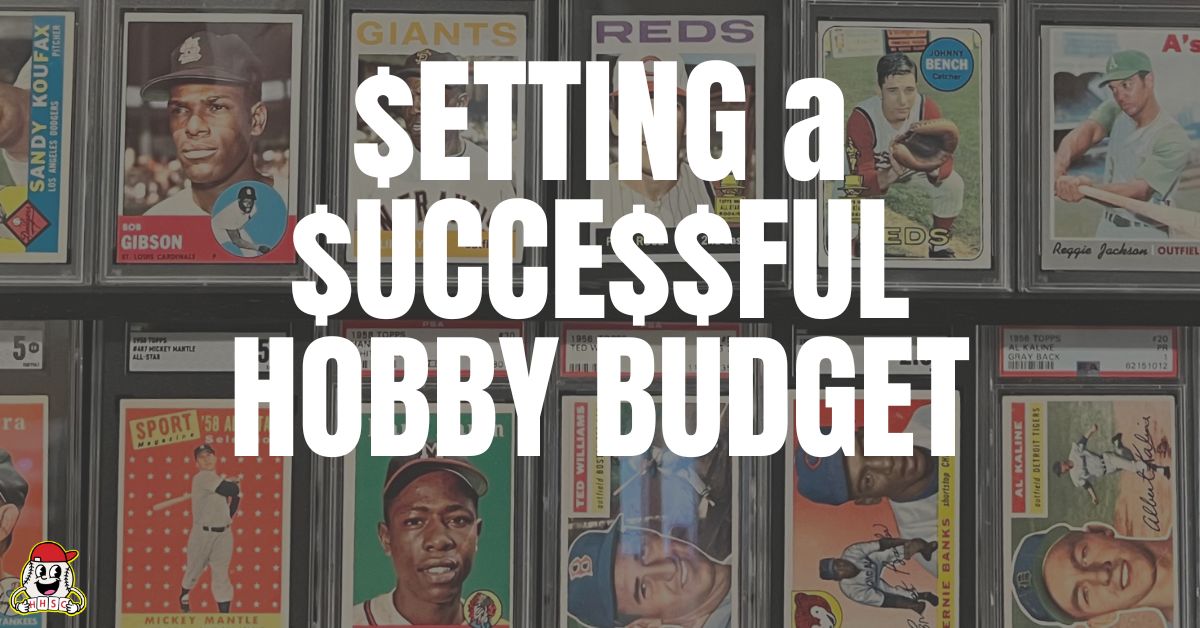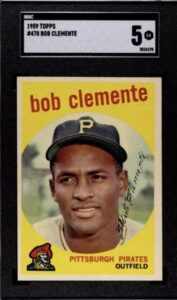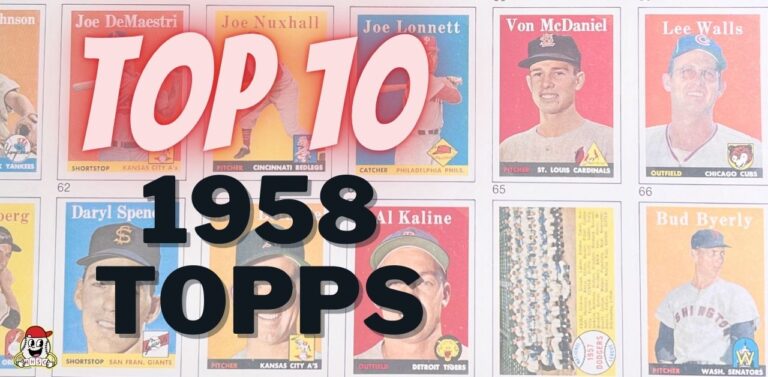Why set a hobby budget? Nothing can ruin a sports card collection like realizing you are spending too much money on cards, and having it affect the rest of your life. By setting up a card-collecting hobby budget, you can take control of your spending, focus your collecting, and improve your enjoyment of the hobby. …
7 Steps To Setting a Card-Collecting Hobby Budget

Why set a hobby budget? Nothing can ruin a sports card collection like realizing you are spending too much money on cards, and having it affect the rest of your life.
By setting up a card-collecting hobby budget, you can take control of your spending, focus your collecting, and improve your enjoyment of the hobby.
In this article, we’re going to walk through some pretty simple steps to help you set up your own hobby budget, helping you take control of your monthly spending.
It sounds like a daunting task, but think of this as another sports card collecting hurdle that will give more weight to your card collection, knowing the cards you get are more special than they were when you spent wildly!
7 Easy Steps To Setting a Card-Collecting Hobby Budget!
Some of the suggestions we make are malleable, so you can adjust as you see fit, but these hobby budget tips should help give you an idea of what you should do.
1. Set Some Realistic Goals
What are you trying to accomplish with your sports card collection? Is it an investment for the future? Are you trying to use this as a money-making venture right now, as opposed to the future? Is it something you’d just like to enjoy, bringing back waves of nostalgia? Is it something to just allow you to enjoy current sports a little more, like Fantasy Sports?
If you are a sports card collector looking to enjoy their collection while also building up some physical assets to sell later on or leave to your family, then you are like me, so I can help with some realistic goals.
Realistic Goal Examples:
Increase My Assets by 5% Percent: If your assets total $10,000, then you hope to increase that by $500 by purchasing things you should be able to sell quickly, like single cards or boxes.
Start or Finish Collecting a Specific Subset: Maybe you are trying to complete a set, and you just need to track down commons. Or you’ve decided to collect a specific player or team, and you can finish collecting an insert set or a special vintage subset.
Improve Your Prospects Collection: Maybe you want to start buying more rookies and prospects, or more boxes and blasters, hoping to build up your cache of young players, hoping they’ll pay off later. This is reasonable, but it’s not a great investment unless you buy in larger quantities. Even so, it might just be how you enjoy collecting, so feel free to budget accordingly.
2. Figure Out What You Can Afford Each Month
This sounds dumb and obvious, but we have to start somewhere! Go through your net income (your take-home pay) and figure out your necessary spending on bills, groceries, savings, utilities, rent/mortgage, etc.
(If you get paid weekly, multiply your take-home pay by 4.33 to give you a monthly number, since there are more than four weeks in a month. You can also decide to set your house budget up for a four-week month, which would give you a full paycheck to use as you wish every three months!)
After bills/savings, that remainder is your disposable income, which you can consider using for your hobby budget.
For the sake of this article, we’re going to say that leftover remainder is $100 per month, available for your hobby budget. (Some will be much more than this, some will be much less.)
3. Decide What Sports / Products You Want To Collect
You can’t collect everything – and I’ve tried! My guess is that you’ve tried, too. Just know that you have the rest of your life to collect, so you can eventually collect other things in later years, but for now, with your limited hobby budget, you want to figure out what you want to collect.
- Which sport? Let’s say baseball.
- Which products for that sport? Let’s say Topps Flagship, Topps Archives, and some Topps Now cards.
- Which dates do those products get released? Topps Series 1 (February), Topps Series 2 (June), Topps Update (October), Topps Archives (November)
Set your budgets for those months so you are able to pre-order those hobby boxes, or so you can buy blasters or singles when they come out.
If you don’t plan on buying any wax, then you can move on because your monthly hobby budget should remain relatively the same each month.
4. Decide What Percentages You Want To Spend On Each Category
Card collecting has several different facets we can spend money on, so we need to think about how much from our monthly hobby budget we’d like to put toward each category.
- Wax: You might have to save multiple months for upcoming releases.
- Breaks: Getting into breaks is fun, but it’s tough to get a great return on investment here. You’ll spend a smaller percentage of the price of a hobby box, but you might just end up with a team or two full of commons.
- Singles – Vintage: If you want to improve your collection directly, without waiting on that investment to climb in value, then buying graded vintage singles is a smart move. It might take up your full monthly budget, though.
- Singles – New: You can buy raw singles of new cards, rather than hobby or retail boxes, and focus solely on investments. The bad news is you won’t have a chance of pulling amazing autographed cards from hobby boxes, but the good news is you’ll have the cards you want at reasonable prices.
- Card Supplies: Unfortunately, we have to spend some of our money on supplies (top-loaders, penny sleeves, top-loader binders, etc.
- Grading: Consider sending cards to get graded once or twice a year, so you can capitalize on grading specials and savings on shipping.
- Hobby Savings: Set a small percentage aside each month from your hobby budget, so that when a great opportunity comes up to get a deal on a hobby box or a vintage star at a discount, you’ll be ready.
5. Review Your Budget Every 3 Months
You might find that you want to increase your percentages at different categories a little more than how you originally set them. Also, you might find you can increase or decrease your hobby budget, depending on what’s happening with you and your family.
6. Supplement Your Hobby Budget with Hobby Income
Once you have a specified amount of money to spend each month on cards, you’ll spend more time on your cards. When you do that, you will find cards you don’t mind selling, and you’ll now have time to list them on places like eBay. Whatever cards you sell on there, you can merge that profit into what you plan to spend that month on cards and improve your sports card collection further.
I like to sell cards to finance better cards of the same players. Does that make sense? For example, I sold a few Roberto Clemente cards (1969 PSA 3 and 1972 PSA 5), added a small amount of cash, and that allowed me to buy a sweet 1959 SGC 5 Clemente slab. I “upgraded” my Clemente collection, essentially.
If you sell a Hank Aaron card for $100, and add $100 cash, you can now buy a $200 Hank Aaron card that only cost you $100 from your hobby budget! Upgrade! That’s called using Opportunity Cost! When you buy one piece, and it’s still part of your portfolio, you can then use that piece to buy into another piece!
7. Go Over Your Hobby Budget with Your Significant Other
This will do a couple things – 1. It will help you stay on budget. 2. Your partner will appreciate the fact you are trying to control your spending.
In the end, if you make wise purchases, your spending can become a version of savings. If you took $100 in March and spent it on a 1969 Topps Hank Aaron PSA 5 slab to go in your card display, you can regularly walk your spouse in and show her that card – “here’s where your $100 is.” And then, one year later, you can point to it again and say, “Here’s where your $100 is still.”

It’s tough to get a good return on investment on hobby boxes and blasters, but there’s value in the fun of opening those packs! If you create a mixture of the two, spending on graded singles to act as a version of savings, and spending on wax for the fun of it, then you can mitigate most of the dangers of collecting.
If you love rookie cards, here are some more articles tracking great cards from the past and present:
- The Most Valuable Baseball Rookie Card of Every Year Since 1948
- 1st Bowman Cards For the Top 100 MLB Prospects in Baseball Right Now!
- Topps Rookie Cards of the Top 100 MLB Players Right Now (2024!)
- The Best Topps Chrome Rookie Cards From Every Year Since 1996
- The Best 2nd-Year Baseball Cards Dating Back to 1953
- The Best BASKETBALL Rookie Cards From Each NBA Season Since 1948
- The Best FOOTBALL Rookie Cards From Each NFL Season Since 1956
- The Best HOCKEY Rookie Cards From Each NHL Season Since 1951
Set a hobby budget today, review it every few months, and enjoy your sports card collection!








